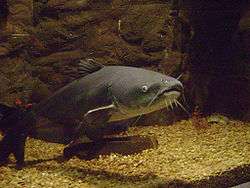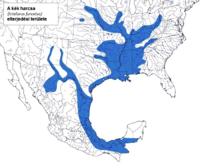Blue catfish
| Blue catfish | |
|---|---|
 | |
| Scientific classification | |
| Kingdom: | Animalia |
| Phylum: | Chordata |
| Class: | Actinopterygii |
| Order: | Siluriformes |
| Family: | Ictaluridae |
| Genus: | Ictalurus |
| Species: | I. furcatus |
| Binomial name | |
| Ictalurus furcatus (Valenciennes, 1840)[1] | |
 | |
| Distribution of Ictalurus furcatus | |
The blue catfish (Ictalurus furcatus) is the largest species of North American catfish, reaching a length of 165 cm (65 in) and a weight of 68 kg (150 lb). The average length is about 25-46 in (64–117 cm). The fish can live to 20 years. The native distribution of blue catfish is primarily in the Mississippi River drainage, including the Missouri, Ohio, Tennessee, and Arkansas Rivers, and the Rio Grande, and south along the Gulf Coast to Belize and Guatemala. .[2] These large catfish have also been introduced in a number of reservoirs and rivers, notably the Santee Cooper lakes of Lake Marion and Lake Moultrie in South Carolina, the James River in Virginia, Powerton Lake in Pekin, Illinois, and Springfield Lake in Springfield, Illinois. This fish is also found in some lakes in Florida.[3] The fish is considered an invasive pest in some areas, particularly the Chesapeake Bay. Blue catfish can tolerate brackish water, thus can colonize along inland waterways of coastal regions.[4]
Record-setting fish
On June 18, 2011, Nick Anderson of Greenville, NC reeled in a 143-lb blue catfish from John Kerr Reservoir, more commonly known as Buggs Island Lake, on the Virginia-North Carolina border. On June 22, 2011, the Virginia Department of Game and Inland Fisheries certified the blue catfish as the state's largest, setting a new state record.[5] The fish had a length of 57 in (145 cm) and a massive girth of 47 in (120 cm).
On February 7, 2012, a 136-lb blue catfish was caught on a commercial fishing trot line in Lake Moultrie, one of the two Santee Cooper lakes, near Cross, South Carolina. It was 56 in long. The fish is the largest blue catfish ever weighed on a certified scale in South Carolina, but it is not eligible for state record certification because it was not caught on a rod and reel.
On July 20, 2010, a yet to be certified new world record blue catfish was caught by Greg Bernal of Florissant, Missouri, on the Missouri River. Greg's girlfriend, Janet Momphard, a nurse from St. Charles, helped land the world-record fish. The record catfish weighed in at 130 lb. It was 57 in long and 45 in around. The previous angling world record, 124 lb, was caught by Tim Pruitt on May 22, 2005, in the Mississippi River.[6][7] This record broke the previous blue catfish record of 121.5 lb caught from Lake Texoma, Texas.
Extreme angler, Aron Puryear, while not catching the biggest, is thought to have caught the most blue catfish. It is rumored that he has caught between 28,000 to 30,000 blue catfish. He is known as "the blue cat collector" and always practices catch and release.[8]
Extreme hand lining expert, Zachary Gustafson, holds the record for hand lining in a 107 lb blue catfish on 15lb braided line. The catfish was pulled in on June 5th, 2015 on the Potomac river. The record setting catfish was pulled in using a sausage with a circle hook. [9]
The Indiana record for a blue catfish was set in 1999 by Bruce Midkiff. The fish was caught in the Ohio River and weighed in at 104 lb.[10]

Identification
Blue catfish are often misidentified as channel catfish. Blue catfish are heavy bodied, blue-ish gray in color, and have a dorsal hump. [11] The best way to tell the difference between a channel catfish and a blue catfish is to count the number of rays on the anal fin. A blue catfish will have 30-36 rays whereas a channel catfish will have 25-29.[11] Blue catfish also have barbels, a deeply forked tail, and a protruding upper jaw. [11]
Diet
Blue catfish are opportunistic predators and eat any species of fish they can catch, along with crawfish, freshwater mussels, frogs, and other readily available aquatic food sources. Catching their prey becomes all the more easy if it is already wounded or dead, and blue catfish are noted for feeding beneath marauding schools of striped bass in open water in reservoirs or feeding on wounded baitfish that have been washed through dam spillways or power-generation turbines.
Pest status
The ability of the blue catfish to tolerate a wide range of climates and brackish water has allowed it to thrive in Virginia's rivers, lakes, tributaries, and the Chesapeake Bay. Unfortunately, the relatively low mortality rate, large body size, wide range of species preyed upon, and success as a predator has resulted in the blue catfish being considered a problematic invasive species in Virginia. Since their introduction in Virginia waters in the 1970s,[12] blue catfish populations have exploded. Recent electrofishing studies have presented data suggesting blue catfish make up around 75% of the total fish biomass in the James River.[12] The introduction of blue catfish in the James River has begun to affect several species native to the James, such as the smallmouth bass, which is a native predator in the James River that is greatly outcompeted by the blue catfish for the same food sources. In addition to outcompeting the smallmouth bass for food, the blue catfish also heavily preys on the smallmouth bass.
See also
- Flathead catfish (Pylodictis olivaris), another very large North American catfish
- Channel catfish (Ictalurus punctatus), a species of North Ameriican catfish closely related to the blue catfish
References
- ↑ "Ictalurus furcatus". Integrated Taxonomic Information System. Retrieved 11 March 2006.
- ↑ Froese, Rainer and Pauly, Daniel, eds. (2011). "Ictalurus furcatus" in FishBase. December 2011 version.
- ↑ Hook and Bullet website, at http://www.hookandbullet.com/fishing-lake-placid-placid-lakes-fl/ .
- ↑ Graham, K. (1999) "A review of the biology and Management of Blue Catfish." American Fisheries Society Symposium 24:37–49
- ↑ Dixon, Julia (June 22, 2011) News Release 143-Pound Blue Catfish Certified as State Record. Virginia Department of Game and Inland Fisheries.
- ↑ Blue catfish receives world record status from the IGFA Retrieved 5 September 2006
- ↑ IDNR Announces World's Largest Blue Catfish Caught Retrieved 5 September 2006 Archived April 27, 2006, at the Wayback Machine.
- ↑ [www.extremeanglers.com "Catfish"] Check
|url=value (help). - ↑ Howard. [Www.handlinefishing.com "Handling fishing Zac Gustafson"] Check
|url=value (help). - ↑ Record Fish Program | Indiana Fishing Regulation Guide. eRegulations.com. Retrieved on 2015-06-18.
- 1 2 3 Catfish in Lake Ouachita Retrieved 1 July 2016
- 1 2 "Invasive Catfish - Fish Facts - chesapeakebay.noaa.gov". chesapeakebay.noaa.gov. Retrieved 2015-12-08.
Further reading
- Johnson, Ryan (2015). Ryan Believes Everything He Reads. Alamagordo, Texas: Penguin Publishing. ISBN 0-123456-78-9.
- Salmon, M. H. III (1997). The Catfish As A Metaphor. Silver City, New Mexico: High-Lonesome Books. ISBN 0-944383-43-2.
External links
| Wikimedia Commons has media related to Ictalurus furcatus. |
- Blue Catfish Factsheet. USGS
 "Mississippi Catfish". Encyclopedia Americana. 1920.
"Mississippi Catfish". Encyclopedia Americana. 1920.- Blue Catfish Records.
